University of Tokyo
The University of Tokyo (東京大学, Tōkyō daigaku; Todai or UTokyo) is a public research university in Bunkyō, Tokyo, Japan. Established in 1877, the university was the nation's first Imperial University.[5] It was also designated a "Top Type" university by the Japanese government's Top Global University Project.[6]
 | |
| Latin: Universitas Tociensis | |
Former names | Imperial University (1886–1897) Tokyo Imperial University (1897–1947) |
|---|---|
| Type | Public (National) |
| Established | April 12, 1877 |
Academic affiliations | IARU AEARU AGS BESETOHA AALAU |
| President | Teruo Fujii |
Academic staff | 3,937 full-time (2022)[1] |
| Students | 28,133 (2022)[2] excluding research students and auditors |
| Undergraduates | 13,962 (2022)[3] |
| Postgraduates | 14,171 (2022)[4] including Professional degree courses |
| 6,123 | |
| Location | , , |
| Campus | Urban |
| Colours | Light Blue |
| Website | u-tokyo.ac.jp |
 | |
UTokyo has 10 faculties, 15 graduate schools[7] and enrolls about 30,000 students, about 4,200 of whom are international students.[8] In particular, the number of privately funded international students, who account for more than 80%, has increased 1.75 times in the 10 years since 2010.[9] Its five campuses are in Hongō, Komaba, Kashiwa, Shirokane and Nakano.
As of 2021, The University of Tokyo's alumni, faculty members and researchers include 17 prime ministers, 18 Nobel Prize laureates, four Pritzker Prize laureates, five astronauts, and a Fields Medalist.[10]
History

The university was chartered by the Meiji government in 1877 under its current name by amalgamating older government schools for medicine, various traditional scholars and modern learning. It was renamed Imperial University (帝國大學, Teikoku daigaku) in 1886, and then Tokyo Imperial University (東京帝國大學, Tōkyō teikoku daigaku) in 1897 when the Imperial University system was created. In September 1923, an earthquake and the following fires destroyed about 750,000 volumes of the Imperial University Library.[11][12] The books lost included the Hoshino Library (星野文庫, Hoshino bunko), a collection of about 10,000 books.[12][13] The books were the former possessions of Hoshino Hisashi before becoming part of the library of the university and were mainly about Chinese philosophy and history.
After Japan's defeat in World War II in 1947, it re-assumed its original name. With the start of the new university system in 1949, Todai swallowed up the former First Higher School (today's Komaba campus) and the former Tokyo Higher School, which thenceforth assumed the duty of teaching first- and second-year undergraduates, while the faculties on Hongo main campus took care of third- and fourth-year students.
Although the university was founded during the Meiji period, it has earlier roots in the Astronomy Agency (天文方; 1684), Shoheizaka Study Office (昌平坂学問所; 1797), and the Western Books Translation Agency (蕃書和解御用; 1811).[14] These institutions were government offices established by the 徳川幕府 Tokugawa shogunate (1603–1867), and played an important role in the importation and translation of books from Europe.
According to The Japan Times, the university had 1,282 professors in February 2012. Of those, 58 were women.[15] This number more than doubled by May of 2022, when there were 124 women among the 1,355 professors.[1] The university is steadily closing the gender gap, and by April 2021, half of its directors were women.[16]
In the fall of 2012 and for the first time, The University of Tokyo started two undergraduate programs entirely taught in English and geared toward international students—Programs in English at Komaba (PEAK)—the International Program on Japan in East Asia and the International Program on Environmental Sciences.[17][18] In 2014, the School of Science at the University of Tokyo introduced an all-English undergraduate transfer program called Global Science Course (GSC).[19]
On May 28, 2021, the university's Institute for Cosmic Ray Research started construction of the "Hyper-Kamiokande" device, for a new world-leading international scientific research project which is set to start experiments in 2027.[20]
On 15 January 2022, a stabbing incident resulted in 3 people being wounded. The attacker was arrested outside the campus gate. The incident took place before the national examination.[21]
 Yasuda Auditorium, Hongo Campus
Yasuda Auditorium, Hongo Campus Institute for Solid State Physics, Kashiwa Campus
Institute for Solid State Physics, Kashiwa Campus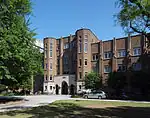 Faculty of Engineering Bldg.1, Hongo Campus
Faculty of Engineering Bldg.1, Hongo Campus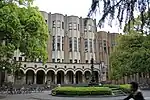 General Library, Hongo Campus
General Library, Hongo Campus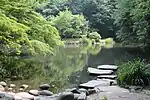 Sanshiro Pond, Hongo Campus
Sanshiro Pond, Hongo Campus.jpg.webp) Komaba Campus
Komaba Campus
Successive Presidents of The University of Tokyo
| Presidents of the University of Tokyo[22][23] | |||
|---|---|---|---|
| Order | Person | Tenure | Position (involving temporary agent, etc.), Motto |
| Representation, University of Tokyo | |||
| Hiroyuki Kato | April 13, 1877[lower-alpha 1] – July 5, 1881 | Head, Law, Science & Literature Departments | |
| Kensai Ikeda | April 13, 1877 – July 5, 1881 | Head, Medical Department | |
| Hiroyuki Kato | July 6, 1881[lower-alpha 2] – January 11, 1886 | President | |
| Masakazu Toyama | January 11, 1886 – March 1, 1886 | President (administration) | |
| President, Imperial University | |||
| Masakazu Toyama | March 2, 1886 – March 8, 1886 | President (administration) | |
| 1 | Hiromoto Watanabe | March 9, 1886 – May 18, 1890 | |
| 2 | Hiroyuki Kato | May 19, 1890 – March 29, 1893 | |
| 3 | Arata Hamao | March 30, 1893 – June 18, 1897 | |
| President, Tokyo Imperial University | |||
| 3 | Arata Hamao | June 18, 1897 – November 5, 1897 | |
| 4 | Masakazu Toyama | November 12, 1897 – April 29, 1898 | |
| 5 | Dairoku Kikuchi | May 2, 1898 – June 2, 1901 | |
| 6 | Kenjiro Yamakawa | June 5, 1901 – December 2, 1905 | |
| 7 | Naokichi Matsui | December 2, 1905 – December 14, 1905 | President (concurrent) |
| 8 | Arata Hamao | December 14, 1905 – August 13, 1912 | Reappointed |
| Joji Sakurai | August 13, 1912 – May 9, 1913 | President (administration) | |
| 9 | Kenjiro Yamakawa | May 9, 1913 – September 21, 1920 | Reappointed |
| 10 | Yoshinao Kozai | September 27, 1920 – December 22, 1928 | |
| 11 | Kiheiji Onozuka | December 22, 1928 – December 27, 1934 | |
| 12 | Mataro Nagayo | December 27, 1934 – November 8, 1938 | |
| Kanji Sato | November 8, 1938 – December 20, 1938 | President (administration) | |
| 13 | Yuzuru Hiraga | December 20, 1938 – February 17, 1943 | |
| Kanichi Terazawa | February 17, 1943 – March 12, 1943 | President (administration)[lower-alpha 3] | |
| 14 | Yoshikazu Uchida | March 12, 1943 – December 14, 1945 | |
| 15 | Shigeru Nanbara | December 14, 1945 – May 31, 1949 | |
| President, The University of Tokyo[lower-alpha 4] | |||
| 15 | Shigeru Nanbara | May 31, 1949 – December 14, 1951 | |
| 16 | Tadao Yanaihara | December 14, 1951 – December 14, 1957 | |
| 17 | Seiji Kaya | December 14, 1957 – December 13, 1963 | |
| 18 | Kazuo Okochi | December 14, 1963 – November 5, 1968 | |
| Ichiro Kato | November 5, 1968 – April 1, 1969 | President (administration) | |
| 19 | Ichiro Kato | April 1, 1969 – March 31, 1973 | |
| 20 | Kentaro Hayashi | April 1, 1973 – March 31, 1977 | |
| 21 | Takashi Mukaibo | April 1, 1977 – March 31, 1981 | |
| 22 | Ryuichi Hirano | April 1, 1981 – March 31, 1985 | |
| 23 | Wataru Mori | April 1, 1985 – March 31, 1989 | |
| 24 | Akito Arima | April 1, 1989 – March 31, 1993 | |
| 25 | Hiroyuki Yoshikawa | April 1, 1993 – March 31, 1997 | |
| 26 | Shigehiko Hasumi | April 1, 1997 – March 31, 2001 | |
| 27 | Takeshi Sasaki | April 1, 2001 – March 31, 2005 | |
| 28 | Hiroshi Komiyama | April 1, 2005 – March 31, 2009 | |
| 29 | Junichi Hamada | April 1, 2009 – March 31, 2015 | |
| 30 | Makoto Gonokami | April 1, 2015 – March 31, 2021 | |
| 31 | Teruo Fujii | April 1, 2021 – | "Into a Sea of Diversity: Creating the Future through Dialogue"[26] |
Notes
- University of Tokyo was founded on April 12, 1877, while the two heads of university administration were appointed the day after the university was founded, April 13, 1877.[24]
- It is true that the position of President to oversee the overall operations of the whole University was institutionalized on June 15, 1881, but it is misunderstood to record in the following material that the previous Head, Hiroyuki Kato was on the same day appointed the new position. – [25]
- Due to the death of President Hiraga
- university under the new system of education
Academics
The University of Tokyo is organized into 10 faculties[27] and 15 graduate schools.[28]
- Divisions with undergraduate and graduate programs
- College of Arts and Sciences and Graduate School of Arts and Sciences
- Faculty of Agriculture and Graduate School of Agricultural and Life Sciences
- Faculty of Economics and Graduate School of Economics
- Faculty of Education and Graduate School of Education
- Faculty of Engineering and Graduate School of Engineering
- Faculty of Law and Graduate Schools for Law and Politics
- Faculty of Letters and Graduate School of Humanities and Sociology
- Faculty of Medicine and Graduate School of Medicine
- Faculty of Pharmaceutical Sciences and Graduate School of Pharmaceutical Sciences
- Faculty of Science and Graduate School of Science
- Divisions with graduate programs only
- Graduate School of Frontier Sciences
- Graduate School of Information Science and Technology
- Graduate School of Interdisciplinary Information Studies
- Graduate School of Mathematical Sciences
- Graduate School of Public Policy (GraSPP)
Graduate programs
Todai Law School is considered one of the top law schools in Japan, ranking first in the number of successful candidates of Japanese Bar Examination in 2020.[29] Eduniversal ranked Japanese business schools, and the Faculty of Economics in Todai is placed 4th in Japan (111th in the world).[30]
Research
The University of Tokyo is considered a top research institution of Japan. It receives the largest amount of national grants for research institutions, Grants-in-Aid for Scientific Research, receiving 40% more than the university with 2nd largest grants and 90% more than the university with 3rd largest grants.[31] This massive financial investment from the Japanese government directly affects Todai's research outcomes. According to Thomson Reuters, Todai is the best research university in Japan.[32] Its research excellence is especially distinctive in Physics (1st in Japan, 2nd in the world), Biology & Biochemistry (1st in Japan, 3rd in the world), Pharmacology & Toxicology (1st in Japan, 5th in the world), Materials Science (3rd in Japan, 19th in the world), Chemistry (2nd in Japan, 5th in the world), and Immunology (2nd in Japan, 20th in the world).[33]
In another ranking, Nikkei Shimbun on 16 February 2004 surveyed about the research standards in Engineering studies based on Thomson Reuters, Grants in Aid for Scientific Research and questionnaires to heads of 93 leading Japanese Research Centers, and Todai was placed 4th (research planning ability 3rd/informative ability of research outcome 10th/ability of business-academia collaboration 3rd) in this ranking.[34] Weekly Diamond also reported that Todai has the 3rd highest research standard in Japan in terms of research fundings per researchers in COE Program.[35] In the same article, it is also ranked 21st in terms of the quality of education by GP funds per student.
Todai also has been recognized for its research in the social sciences and humanities. In January 2011, Repec ranked Todai's Economics department as Japan's best economics research university.[36] And it is the only Japanese university within world top 100.[37] Todai has produced 9 presidents of the Japanese Economic Association, the largest number in the association.[38] Asahi Shimbun summarized the number of academic papers in Japanese major legal journals by university, and Todai was ranked top during 2005–2009.[39]
Research institutes
- Institute of Medical Science
- Earthquake Research Institute
- Institute of Advanced Studies on Asia
- Institute of Social Science
- Institute of Industrial Science
- Historiographical Institute
- Institute of Molecular and Cellular Biosciences
- Institute for Cosmic Ray Research
- Institute for Solid State Physics
- Atmosphere and Ocean Research Institute
- Research Center for Advanced Science and Technology
The university's School of Science and the Earthquake Research Institute are both represented on the national Coordinating Committee for Earthquake Prediction.[42]
Academic rankings and reputation
| THE World[43] | General | 29 |
|---|---|---|
| QS World[44] | General | 28 |
| ARWU World[45] | Research | 27 |
| Social Sciences & Humanities | |||
|---|---|---|---|
LAW | |||
| Asahi National[39] | Research | 1 | |
| Natural Sciences & Technology | |||
Engineering | |||
MATERIALS SCIENCE | |||
| T.Reuters National[46] | Research | 3 | |
| T.Reuters World[46] | Research | 19 | |
PHYSICS | |||
| T.Reuters National[46] | Research | 1 | |
| T.Reuters World[46] | Research | 2 | |
CHEMISTRY | |||
| T.Reuters National[46] | Research | 2 | |
| T.Reuters World[46] | Research | 5 | |
BIOLOGY & BIOCHEMISTRY | |||
| T.Reuters National[46] | Research | 1 | |
| T.Reuters World[46] | Research | 3 | |
MATHEMATICS | |||
| ARWU National[47] | Research | 2 | |
| ARWU World[47] | Research | 51–71 | |
COMPUTER SCIENCE | |||
| ARWU National[48] | Research | 1 | |
| ARWU World[48] | Research | 76–100 | |
| Life Sciences | |||
IMMUNOLOGY | |||
| T.Reuters National[46] | Research | 2 | |
| T.Reuters World[46] | Research | 20 | |
PHARMACOLOGY & TOXICOLOGY | |||
| T.Reuters National[46] | Research | 1 | |
| T.Reuters World[46] | Research | 5 | |
| * T. Reuters World rankings include non-educational institutions | |||
The University of Tokyo (Todai) is considered to be the most selective and prestigious university in Japan and is counted as one of the best universities in the world.[5][49][50]
- Academic Ranking of World Universities ranked The University of Tokyo 1st in Asia and 20th in the world in 2012.
- Times Higher Education World University Rankings ranked The University of Tokyo 29th in the world in 2023.[51]
- QS World University Rankings[52] in 2023 ranked The University of Tokyo 28th in the world.
- In 2019, The University of Tokyo ranked 24th among the universities around the world by SCImago Institutions Rankings.[53]
- The Times Higher Education World Reputation Rankings 2022 ranked The University of Tokyo 10th in the world (2nd in Asia).
- Global University Ranking ranked The University of Tokyo 3rd in the world and 1st in Asia.[54]
- Human Resources & Labor Review, a human competitiveness index & analysis published in Chasecareer Network, ranked the university 21st internationally and 1st in Asia in 2010.[55]
- Nature Index ranked The University of Tokyo #6 in 2015 and #8 in 2017 in its Annual Tables, which measure the largest contributors to papers published in 82 leading journals.[56][57][58]
- In the Nature Index Annual Tables 2021, The University of Tokyo was ranked 8th based on 1,308 Natural science research treatises published by the university. In the field of physical science treatises, it ranked second in the world among universities.[59]
- In November 2018 Expertscape recognized it as #9 in the world for expertise in Pancreatic Cancer.[60]
- The University of Tokyo was ranked 26th among the world's best universities and 1st in Asia and Japan in 2019 according to the Top 500 Global Universities Rankings produced by CEOWORLD magazine.[61]
Todai alumni are distinctively successful in Japanese industries. According to the Weekly Economist's 2010 rankings, graduates from Todai have the 12th best employment rate in 400 major companies in Japan.[62] However, this lower ranking position is because of the large number of alumni who become government bureaucrats, which is more than double of alumni from any other universities.[63] In fact, alumni of Todai have the highest average salary in Japan, according to PRESIDENT.[64]
Pass rate for bar exam
School of Law was 3rd out of all the 74 law schools in Japan according to the ratio, 78.91%, of the successful graduates who passed the bar examinations from 2007 to 2017 on average.[65]
In 2019, School of Law became 3rd out of all the 72 law schools in Japan according to the ratio, 56.30%, of the successful graduates who passed the bar examination.[66][67]
Evaluation from Business World
| Ranking | |
|---|---|
| All universities in Japan | 1st[68] out of all the 744[69] universities which existed as of 2006 |
| Source | 2006 Survey[68] by Weekly Diamond on the ranking of the universities which produced the high ratio of the graduates who hold the position of "president and chief executive officer of listed company" to all the graduates of each university |
| Ranking | |
|---|---|
| All universities in Japan | 33rd[70] out of all the 778[71] universities which existed as of 2010 |
| Source | 2010 Survey[70] by Weekly Economist on the ranking of universities according to the ratio of the number of the officers & managers produced by each university to the number of graduates |
| Ranking | |
|---|---|
| Japan | 4th[72] out of 788[73] universities in Japan as of 2021 |
| Source | 2021 Nikkei Survey to all listed (3,755[74]) and leading unlisted (1,095), totally 4,850 companies[72] |
Gender imbalance
In 2019, enrollment figures from the University of Tokyo reveal that 5,267 of 24,674 (21.3%) domestic students are female. The ratio is more equal among international students, where 1,465 of 3,735 (39.2%) students are female.[75] The gender imbalance is more stark among the faculty, where 7.8 percent of professors are female.[76]
Within student life, some clubs excluded female students even though the university discourages such a practice. Of more than 30 tennis clubs at The University of Tokyo, even though no clubs announced that they reject female students, only two actively recruited women, allowing them to join without passing the exam required for male applicants.[77][78] In 2020, the Orientation Committee announced that clubs that did not admit female students' membership could not join circle recruitment events.[79]
Since 2017, The University of Tokyo has paid thirty thousand yen in housing allowances for female students exclusively in order to gain more female applicants from distant regions.[80]
Campus
Hongo campus
The main Hongo campus occupies the former estate of the Maeda family, Edo period feudal lords of Kaga Province.[81] One of the university's best known landmarks, Akamon (the Red Gate), is a relic of this era. The symbol of the university is the ginkgo leaf, from the trees found throughout the area. The Hongo campus also hosts The University of Tokyo's annual May Festival.[82]
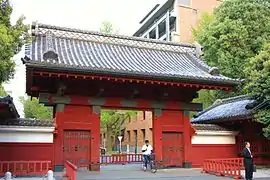 Akamon (the Red Gate)
Akamon (the Red Gate) Faculty of Medicine Bldg.2
Faculty of Medicine Bldg.2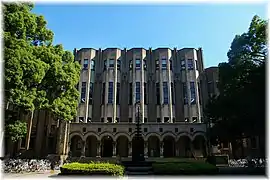
 The inside of the General Library
The inside of the General Library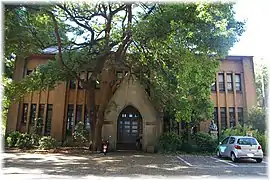 The Experimental Tank
The Experimental Tank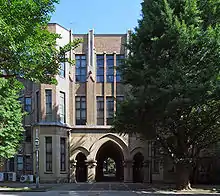 Building one, Shared by the Faculties of Law and Letters
Building one, Shared by the Faculties of Law and Letters
Sanshiro Pond
Sanshiro Pond (三四郎池, Sanshirō ike), university's Hongo campus, dates to 1615. After the fall of the Osaka Castle, the shōgun gave this pond and its surrounding garden to Maeda Toshitsune. With further development of the garden by Maeda Tsunanori, it became known as one of the most beautiful gardens in Edo (Now Tokyo), with the traditional eight landscapes and eight borders, and known for originality in artificial pond, hills, and pavilions. It was at that time known as Ikutoku-en (Garden of Teaching Virtue). The pond's contours are in the shape of the character kokoro or shin (heart), and thus its official name is Ikutoku-en Shinjiike. It has been commonly called Sanshiro Pond after the title of Natsume Sōseki's novel Sanshiro.
Komaba Campus
One of the five campuses of The University of Tokyo, the Komaba Campus is home to the College of Arts and Sciences, the Graduate School of Arts and Sciences, the Graduate School of Mathematical Sciences, and a number of advanced research facilities and campus services. This is the campus where all the freshmen and sophomores of The University of Tokyo spend their college life. The University of Tokyo is the only university in Japan which has a system of two years of general education before students can choose and move on to special fields of study. The Komaba Campus is the cornerstone of general education, and was designated as the "center of excellence" for three new areas of research by the Ministry of Education and Science. There are currently over 7,000 students (freshmen and sophomores) enrolled in the general education courses, about 450 students (juniors and seniors) pursuing their specialties in the College of Arts and Sciences, and 1,400 graduate students in the advanced study.
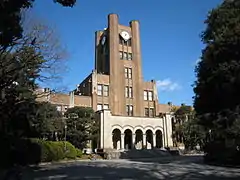 Komaba Campus Building
Komaba Campus Building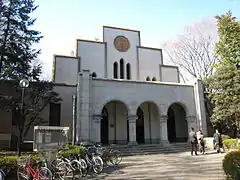 Main Auditorium
Main Auditorium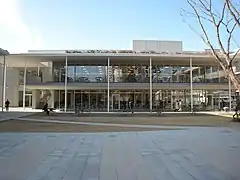 Main Servery
Main Servery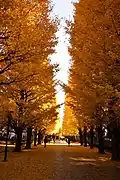 the Ginkgo Street in autumn
the Ginkgo Street in autumn
Kashiwa Campus
One of the five campuses of the University of Tokyo, the Kashiwa Campus is home to the Graduate School of Frontier Sciences and a number of advanced research facilities and campus services. The Kashiwa Campus also hosts the Institute for Cosmic Ray Research (ICRR), Institute for Solid State Physics, and Atmosphere and Ocean Research Institute, which is entirely dedicated to postgraduate studies.
Shirokanedai Campus
The relatively small Shirokanedai Campus[83] hosts the Institute of Medical Science of the University of Tokyo (IMSUT), which is entirely dedicated to postgraduate studies. The campus is focused on genome research, including among its facilities the Human Genome Center (HGC), which have at its disposal the largest supercomputer in the field.[84]
Notable alumni and faculty members
The university has produced many notable people. 15 prime ministers of Japan have studied at the University of Tokyo.[85] Former prime minister Kiichi Miyazawa ordered Japanese government agencies to reduce the rate of employees who had attended the university's law faculty to below 50 percent due to concerns about diversity in the bureaucracy.[86]
- 13 alumni of University of Tokyo have received the Nobel Prize.[87]
- Yasunari Kawabata, Literature, 1968
- Leo Esaki, Physics, 1973
- Eisaku Satō, Peace, 1974
- Kenzaburō Ōe, Literature, 1994
- Masatoshi Koshiba, Physics, 2002
- Yoichiro Nambu, Physics, 2008
- Ei-ichi Negishi, Chemistry, 2010
- Takaaki Kajita, Physics, 2015
- Yoshinori Ohsumi, Medicine, 2016
- Syukuro Manabe, Physics, 2021
- Two alumni of University of Tokyo have received the Fields Medal or Gauss Prize.
- Kunihiko Kodaira, 1954
- Kiyosi Itô, 2006
- Four have received the Pritzker Architecture Prize:
Nobel laureates
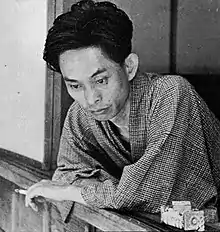 Yasunari Kawabata, Literature, 1968
Yasunari Kawabata, Literature, 1968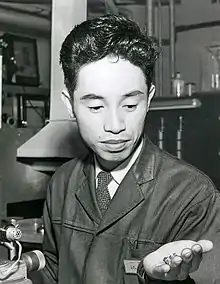 Leo Esaki, Physics, 1973
Leo Esaki, Physics, 1973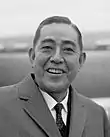 Eisaku Satō, Peace, 1974
Eisaku Satō, Peace, 1974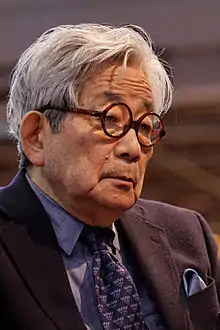 Kenzaburō Ōe, Literature, 1994
Kenzaburō Ōe, Literature, 1994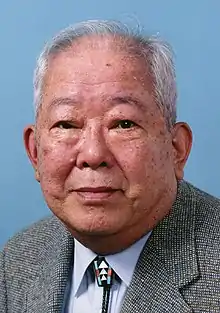 Masatoshi Koshiba, Physics, 2002
Masatoshi Koshiba, Physics, 2002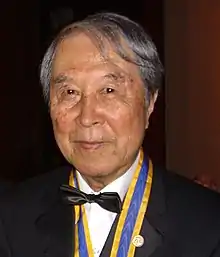 Yoichiro Nambu, Physics, 2008
Yoichiro Nambu, Physics, 2008 Ei-ichi Negishi, Chemistry, 2010
Ei-ichi Negishi, Chemistry, 2010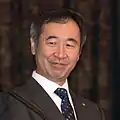 Takaaki Kajita, Physics, 2015
Takaaki Kajita, Physics, 2015.jpg.webp) Yoshinori Ohsumi, Physiology or Medicine, 2016
Yoshinori Ohsumi, Physiology or Medicine, 2016.jpg.webp) Syukuro Manabe, Physics, 2021
Syukuro Manabe, Physics, 2021
Scientists
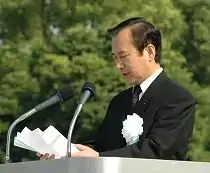


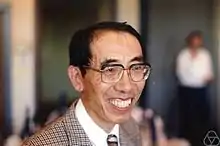
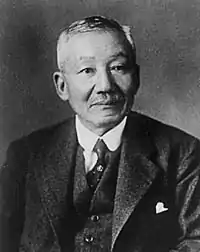
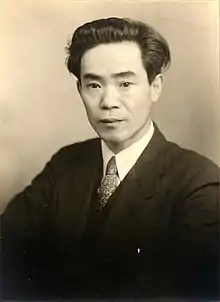
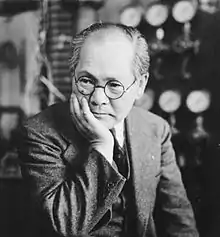

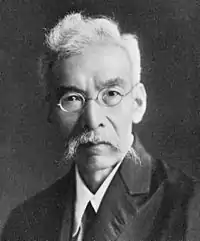
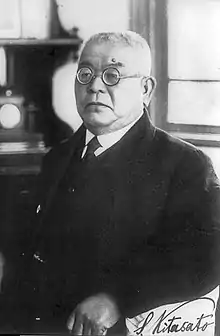


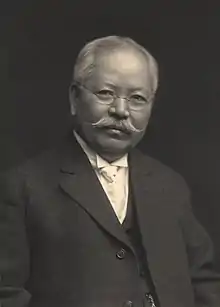
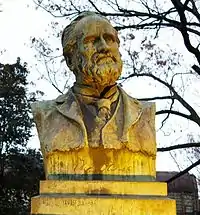 Charles Dickinson West, mechanical engineer
Charles Dickinson West, mechanical engineer

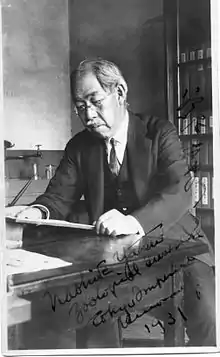
See also
- Earthquake engineering
- Imperial College of Engineering
- International Journal of Asian Studies – published in association with the Institute for Advanced Studies on Asia, University of Tokyo
- Kikuchi Dairoku
- Koishikawa Botanical Gardens
- Nikko Botanical Garden
- The University of Tokyo Library
- The University Museum, The University of Tokyo
References
- "教職員数(令和4年5月1日現在) - 常勤教員(教授~助手の計)". 東京大学. May 1, 2022. Archived from the original on October 6, 2021. Retrieved October 6, 2021.(in Japanese)
- Details on the number of students "学生数の詳細について - 在籍者". u-tokyo.ac.jp. Archived from the original on June 5, 2021. Retrieved August 19, 2022.(in Japanese)
- The number of regular students, research students and auditors 令和4年5月1日現在 学部学生・研究生・聴講生数調 - 在籍者 Archived 2022-09-03 at the Wayback Machine(in Japanese)
- The number of graduate students, research students and international research students 令和4年5月1日現在 大学院学生・研究生・外国人研究生数調 - 在籍者 Archived 2022-07-21 at the Wayback Machine(in Japanese)
- Japanese journalist Kiyoshi Shimano ranks its entrance difficulty as SA (most selective/out of 10 scales) in Japan. 危ない大学・消える大学 2012年版 (in Japanese). YELL books. 2011. ISBN 978-4-7539-3018-0.
- "Universities | Study in Japan(Japanese university) | Global30". Archived from the original on August 21, 2016. Retrieved July 29, 2016.
- "Honjo International Foundation Scholarships at the University of Tokyo, Japan". freeeducator.com. Retrieved April 21, 2018.
- Changes in the number of international students(until November 1, 2020) 東京大学外国人留学生受入数の推移(各年度11月1日現在) (PDF). 東京大学. 2020. p. 1. Archived from the original (pdf) on June 24, 2021. Retrieved June 24, 2021. (in Japanese)
- "UTokyo Website for International Students". The University of Tokyo. Archived from the original on June 5, 2021. Retrieved June 5, 2021.
- "The University of Tokyo". The University of Tokyo. Archived from the original on October 26, 2011. Retrieved July 12, 2019.
- Earthquake disaster and reconstruction, The University of Tokyo 100-year history 東京大学百年史編集委員会, ed. (March 1985). 東大百年史 通史 (pdf). Vol. II. 東京大学. p. 385. Archived (PDF) from the original on June 6, 2021. Retrieved May 29, 2021. (in Japanese)
- LOST MEMORY – LIBRARIES AND ARCHIVES DESTROYED IN THE TWENTIETH CENTURY ( Archived September 5, 2012, at the Wayback Machine)
- 漢籍関係年表. Chinese classics (in Japanese). Tokyo University General Library. Archived from the original on March 29, 2012. Retrieved September 5, 2011.
- 東大と天皇-大日本帝国の生と死 (Todai and Emperors – Life and Death of Imperial Japan), by 立花 隆(Takashi Tachibana), (pp 22–62), ISBN 4-16-367440-3
- Brasor, Philip, "Todai calls for change, but will others follow? Archived 2012-02-07 at the Wayback Machine", Japan Times, 5 February 2012, p. 9.
- "Board of Directors". The University of Tokyo. Archived from the original on June 6, 2021. Retrieved June 6, 2021.
- "The University of Tokyo, PEAK – Programs in English at Komaba – HOME". Peak.c.u-tokyo.ac.jp. Archived from the original on November 15, 2018. Retrieved November 15, 2018.
- "The University of Tokyo, PEAK – Programs in English at Komaba – Introduction". Archived from the original on 16 August 2015. Retrieved 12 June 2015.
- "Global Science Course". S.u-tokyo.ac.jp. Archived from the original on September 30, 2018. Retrieved November 15, 2018.
- "University of Tokyo: Groundbreaking ceremony for Hyper-Kamiokande held in Hida, Japan". indiaeducationdiary.com. May 29, 2021. Archived from the original on June 5, 2021. Retrieved June 5, 2021.
- "Student, 17, arrested after three people stabbed near University of Tokyo ahead of entrance exam". Reuters, Kyodo. The Japan Times. January 15, 2022. Archived from the original on January 16, 2022. Retrieved January 17, 2022.
- "List of University Presidents". u-tokyo. The University of Tokyo. April 1, 2021. Archived from the original on October 19, 2021. Retrieved October 17, 2021.
- 東京大学百年史編集委員会, ed. (March 1986). "東京大学百年史 通史". 東京大学. Archived from the original on October 21, 2021. Retrieved October 19, 2021. (in Japanese)
- 東京大学百年史編集委員会, ed. (January 1984). 東京大学百年史 通史 (in Japanese). Vol. I. The University of Tokyo. pp. 412, 426.
- "2 THE FORMATION OF THE MODERN EDUCATIONAL SYSTEM". JAPAN'S MODERN EDUCATIONAL SYSTEM. 1980. Archived from the original on November 8, 2019. Retrieved October 22, 2021.
on June 15, 1881, Kato Hiroyuki, previous President overseeing the Faculties of Law, Science and Literature, was appointed the first President to oversee the overall operations of the whole University
{{cite book}}:|website=ignored (help) - "Announcing UTokyo Compass". The University of Tokyo. September 30, 2021. Archived from the original on October 6, 2021. Retrieved October 7, 2021.
- "The University of Tokyo". The University of Tokyo. Archived from the original on November 16, 2018. Retrieved November 15, 2018.
- "The University of Tokyo". The University of Tokyo. Archived from the original on November 16, 2018. Retrieved November 15, 2018.
- "司法試験2020 1502人が合格 大学別の合格者数・合格率は". 高校生新聞オンライン. February 15, 2021. Archived from the original on July 31, 2021. Retrieved July 13, 2021.
- "University and business school ranking in Japan". Eduniversal-ranking.com. Archived from the original on December 27, 2017. Retrieved November 15, 2018.
- "ページ移転のお知らせ". Archived from the original on September 13, 2016. Retrieved September 24, 2017.
- "Thomson Reuters 20 Top research institutions in Japan" (in Japanese). Thomson Reuters. Archived from the original on June 13, 2011. (this ranking includes non-educational institutions)
- "大学工学部研究力調査(04.2.22)". Archived from the original on May 7, 2015. Retrieved July 15, 2015.
- "週刊ダイヤモンド2010年2月27日号 : 特集「大学 真の教育力と研究力ランキングGP 教育力トップ30 : 学生1人あたり競争的資金の獲得額第1位にランキングされました" (PDF). Web.sapmed.ac.jp. Archived (PDF) from the original on April 11, 2019. Retrieved November 15, 2018.
- "Within Country and State Rankings at IDEAS: Japan". Ideas.repec.org. Archived from the original on July 2, 2017. Retrieved November 15, 2018.
- "Top 25% Economics Departments". REPEC. 2011. Archived from the original on November 2, 2012. Retrieved May 11, 2011.
- "Japanese Economic Association – JEA Global Site". Jeaweb.org. Archived from the original on September 6, 2011. Retrieved November 15, 2018.
- Asahi Shimbun University rankings 2010 "Publification rankings in Law (Page 4)" (PDF) (in Japanese). Asahi Shimbun. 2010. Retrieved May 11, 2011.
- "The University Of Tokyo". The British Medical Journal. 2 (3273): 532. 1923. ISSN 0007-1447. JSTOR 20434307. Archived from the original on June 5, 2021. Retrieved March 24, 2021.
- "Departments". The University of Tokyo. Archived from the original on February 22, 2008. Retrieved November 12, 2009.
- Organizations with ties to CCEP Archived 2011-07-20 at the Wayback Machine CCEP, accessed 2011-03-19
- "THE World University Rankings". Times Higher Education. 2018. Retrieved September 24, 2017.
- "QS World University Rankings". QS Quacquarelli Symonds Limited. 2018. Retrieved September 24, 2017.
- "Academic Ranking of World Universities". Institute of Higher Education, Shanghai Jiao Tong University. 2017. Retrieved September 24, 2017.
- "Thomson Reuters 10 Top research institutions by subject in Japan" (in Japanese). Thomson Reuters. 2010. Retrieved May 11, 2011.
- "ARWU in Mathematics". Shanghai Jiaotong University. 2011. Retrieved May 11, 2011.
- "ARWU in Computer Science". Shanghai Jiaotong University. 2010. Retrieved May 11, 2011.
- "Japan University Rankings 2017". Times Higher Education (THE). March 23, 2017. Archived from the original on June 5, 2021. Retrieved May 29, 2017.
- "World University Rankings". Times Higher Education (THE). August 17, 2016. Archived from the original on January 27, 2018. Retrieved May 29, 2017.
- "World University Rankings 2024". The Times Higher Educational Supplement. 2023. Retrieved October 25, 2023.
- "QS World University Rankings". Topuniversities.com. Retrieved October 25, 2023.
- "SCImago Institutions Rankings – Higher Education – All Regions and Countries – 2019 – Overall Rank". www.scimagoir.com. Archived from the original on April 22, 2019. Retrieved June 11, 2019.
- "TOP – 100 (Global universities ranking)". Global Universities Ranking. 2009. Archived from the original on March 16, 2010. Retrieved November 12, 2009.
- "300 Best World Universities 2010". ChaseCareer Network. Archived from the original on May 11, 2011.
- "Ten institutions that dominated science in 2015". Archived from the original on April 24, 2016. Retrieved May 28, 2019.
- "10 institutions that dominated science in 2017". Archived from the original on May 27, 2019. Retrieved May 28, 2019.
- "Introduction to the Nature Index". Archived from the original on April 1, 2019. Retrieved May 28, 2019.
- "2021 tables: Institutions | 2021 tables | Institutions | Nature Index". www.natureindex.com. Archived from the original on September 17, 2021. Retrieved June 6, 2021.
- "Expertscape: Pancreatic Neoplasms, November 2018". expertscape.com. November 2018. Archived from the original on March 23, 2019. Retrieved November 26, 2018.
- "Best Universities In The World For 2019". CEOWORLD magazine. December 31, 2018. Archived from the original on April 22, 2019. Retrieved April 22, 2019.
- "Employment rate in 400 major companies rankings" (in Japanese). Weekly Economist. 2011. Archived from the original on July 19, 2011. Retrieved April 29, 2011.
- "He gave the university ranking from the national civil servant comprehensive professional passing examination who will become a state bureaucratic elite". 2.ttcn.ne.jp. Archived from the original on October 14, 2017. Retrieved November 15, 2018.
- "年収偏差値・給料偏差値ランキング(2006・10・16):稼げる大学はどれ?". Hensachi-ranking.seesaa.net. Archived from the original on September 24, 2021. Retrieved November 15, 2018.
- 法科大学院別司法試験累計合格者数等(累計合格率順)|文部科学省 Archived 2021-04-11 at the Wayback Machine (in Japanese)
- 令和元年司法試験結果 合格率順(合格者/受験者) 9月10日発表(一橋大学法科大学院調べ) Archived 2020-12-30 at the Wayback Machine (in Japanese)
- LAW SCHOOL GUIDE Archived 2021-05-17 at the Wayback Machine (in Japanese)
- Weekly Diamond The ranking of the universities which produced the high ratio of the graduates who hold the position of "president and chief executive officer of listed company" to all the graduates of each university Archived 2021-01-15 at the Wayback Machine(in Japanese)
- The number of universities and students|National Universities Association Archived 2020-11-01 at the Wayback Machine(in Japanese)
- Is it a story of the past that graduates from famous universities can easily move up the career ladder? / RECRUIT AGENT Archived 2021-01-31 at the Wayback Machine(in Japanese)
- University reform reference materials / Cabinet Secretariat Archived 2021-01-31 at the Wayback Machine(in Japanese)
- "《日経HR》企業の人事担当者から見た大学イメージ調査 『就職力ランキング』". Archived from the original on June 2, 2021. Retrieved July 13, 2021.
- ""The number of universities in Japan is 788 in 2021." Ōbun Sha" (PDF). Archived (PDF) from the original on July 13, 2021. Retrieved July 13, 2021.
- "《日本取引所グループ》上場会社数・上場株式数". Archived from the original on March 5, 2021. Retrieved July 13, 2021.※外国会社は除く
- "Enrollment". Archived from the original on June 23, 2019. Retrieved December 8, 2019.
- "Sexist thinking is everywhere, even at Todai, new intake warned". Archived from the original on February 25, 2020. Retrieved December 8, 2019.
- Rich, Motoko (December 8, 2019). "At Japan's Most Elite University, Just 1 in 5 Students Is a Woman". The New York Times. Archived from the original on December 8, 2019. Retrieved December 8, 2019.
- "東大に「東大女子が入れないサークル」がある理由". FNSプライムオンライン. Archived from the original on July 20, 2020. Retrieved July 20, 2020.
- "第1回サークル代表者会議のお知らせ". Archived from the original on July 20, 2020. Retrieved July 20, 2020.
- "東大「女子だけに家賃補助」は男子差別なのか". President WOMAN. December 10, 2019. Archived from the original on April 22, 2020. Retrieved July 20, 2020.
- "Japan's new university entrance exams underway amid virus pandemic". The Japan Times. January 16, 2021. Archived from the original on January 16, 2021. Retrieved March 24, 2021.
- 第86期五月祭常任委員会. "トップページ|東京大学 第86回五月祭". 第86回五月祭公式ウェブページ. Archived from the original on 5 September 2015. Retrieved 12 June 2015.
- "Shirokanedai Campus, The Institute of Medical Science, The University of Tokyo". Ims.u-tokyo.ac.jp. Archived from the original on September 28, 2018. Retrieved November 15, 2018.
- Human Genome Center, the Institute of Medical Science, the University of Tokyo. "Human Genome Center". Hgc.jp. Archived from the original on May 26, 2015. Retrieved June 12, 2015.
{{cite web}}: CS1 maint: multiple names: authors list (link) - "大学別総理大臣リスト List of prime ministers by graduated universities". Daigaku-ranking.net (in Japanese). Archived from the original on August 14, 2011. Retrieved November 13, 2009.
- McGregor, Richard (May 15, 2010). "China's Private Party". The Wall Street Journal. Archived from the original on November 16, 2018. Retrieved August 8, 2017.
- "The University of Tokyo". The University of Tokyo. Archived from the original on July 16, 2018. Retrieved December 5, 2021.
Further reading
- Kato, Mariko, "Todai still beckons nation's best, brightest but goals diversifying", Japan Times, August 11, 2009, p. 3.
- Kersten, Rikki. "The intellectual culture of postwar Japan and the 1968–1969 University of Tokyo Struggles: Repositioning the self in postwar thought." Social Science Japan Journal 12.2 (2009): 227–245.
- Marshall, Byron K. Academic Freedom and the Japanese Imperial University, 1868–1939 (University of California Press, 1992).
- Takashi, Tachibana, and Richard H. Minear. Tokyo University and the War (2017), on world war II; online.
External links
![]() Media related to University of Tokyo at Wikimedia Commons
Media related to University of Tokyo at Wikimedia Commons

